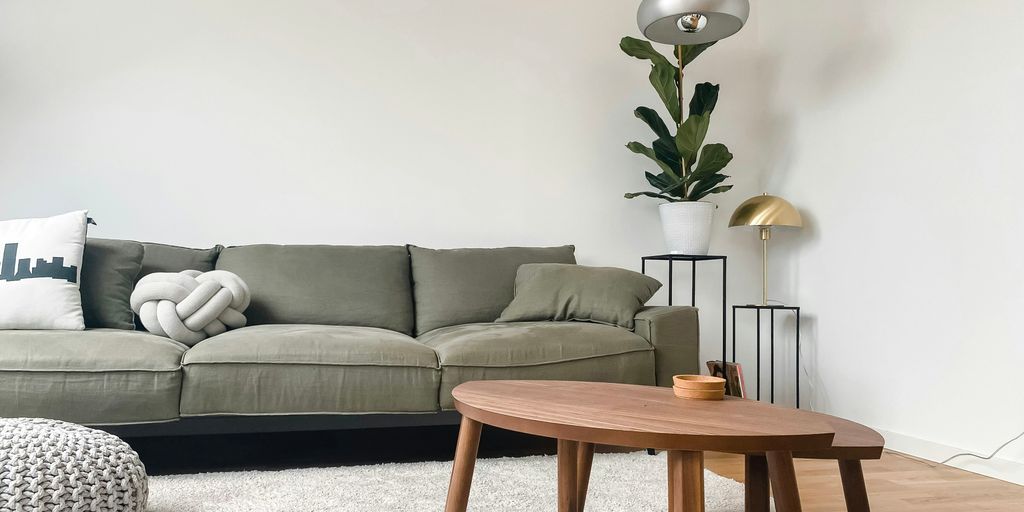Home and Garden
Transform Your Space: A Guide to Minimalist House Interior Design in 2025

If you’re aiming to create a clean, stylish, and clutter-free environment, minimalist house interior design is your best bet for 2025. This approach isn’t just about having fewer items; it’s about making smart choices that focus on quality and simplicity. With roots in Scandinavian design, minimalism emphasizes functionality and a connection to nature, making your home a peaceful retreat. In this guide, we’ll cover the essential elements of minimalist design to help you transform your space into an elegant sanctuary.
Key Takeaways
- Minimalism is about simplicity and functionality, focusing on essential items that serve a purpose.
- A neutral color palette creates a calm atmosphere, while accents can add subtle touches without overwhelming the space.
- Incorporating smart storage solutions helps maintain a clutter-free environment, making the most of your open spaces.
- Using natural materials and indoor plants can enhance your home’s connection to nature and improve overall well-being.
- Sustainable practices, like choosing timeless designs and eco-friendly materials, are key to modern minimalist design.
Understanding The Core Principles Of Minimalist House Interior Design

Simplicity And Functionality
Minimalist design is all about getting rid of the excess and focusing on what’s truly needed. Every item should have a purpose, whether it’s functional or adds to the overall feel of the space. Think clean lines, open spaces, and furniture that doesn’t overwhelm the room. It’s not just about having less stuff; it’s about having the right stuff. For example, instead of having a bunch of decorative items on a shelf, maybe just have a few carefully chosen pieces that you really love. This approach helps to create a calm and uncluttered environment.
Neutral Color Palette
When it comes to colors, minimalist interiors usually stick to a neutral palette. Think whites, grays, beiges, and other soft, muted tones. These colors create a sense of calm and openness. You can add pops of color with things like cushions or artwork, but the overall look should be understated. A neutral backdrop allows the aesthetic appeal of the space to shine through without being visually overwhelming. It’s like a blank canvas that lets the other elements in the room stand out.
Emphasis On Natural Light
Natural light is super important in minimalist design. Big windows, sheer curtains, and open spaces help to maximize the amount of light that comes into the room. Natural light makes a room feel bigger, brighter, and more inviting. It also helps to create a connection with the outdoors. If you don’t have a lot of natural light, you can use modern investing strategies to brighten up the space, but nothing beats the real thing. Think about how the light changes throughout the day and how it affects the feel of the room.
Creating A Minimalist Living Room That Inspires
The living room is often the heart of a home, a place for relaxation, entertainment, and connection. Creating a minimalist living room isn’t about sacrificing comfort; it’s about curating a space that promotes tranquility and focus. It’s about making intentional choices that enhance the room’s functionality and aesthetic appeal. Let’s explore how to transform your living room into an inspiring minimalist haven.
Choosing The Right Furniture
Selecting the right furniture is key to achieving a minimalist aesthetic. Look for pieces with clean lines, simple shapes, and neutral colors. A well-designed sofa is a must, but avoid anything too bulky or ornate. Think about modular sofas that can be rearranged to suit different needs. A simple coffee table, perhaps made of wood or glass, can serve as a focal point without overwhelming the space. Consider these points when selecting furniture:
- Prioritize quality over quantity: Invest in fewer, high-quality pieces that will last for years.
- Choose neutral colors: Stick to a palette of whites, grays, and beiges for a calming effect.
- Consider multi-functional furniture: Ottomans with storage, or sofas that convert into beds, can maximize space.
Incorporating Smart Storage Solutions
Clutter is the enemy of minimalism. Smart storage solutions are essential for keeping your living room organized and clutter-free. Built-in shelves, hidden storage compartments, and wall-mounted cabinets can help you maximize space and keep items out of sight. Baskets and bins can also be used to store smaller items, such as blankets, pillows, and remote controls. Here are some ideas for smart storage:
- Use vertical space: Install shelves or cabinets that reach the ceiling to maximize storage.
- Choose furniture with built-in storage: Ottomans, coffee tables, and sofas with hidden compartments can provide extra storage space.
- Declutter regularly: Get rid of anything you don’t need or use to prevent clutter from accumulating.
Maximizing Open Space
Open space is a defining characteristic of minimalist design. To maximize open space in your living room, avoid overcrowding the room with furniture and accessories. Leave plenty of room to move around freely. Arrange furniture in a way that promotes flow and creates a sense of spaciousness. Natural light can also enhance the feeling of openness. Consider these tips for maximizing open space:
- Arrange furniture strategically: Position furniture away from walls to create a sense of spaciousness.
- Use mirrors to reflect light: Mirrors can make a room feel larger and brighter.
- Keep the floor clear: Avoid cluttering the floor with rugs, plants, or other items. A minimalist design can really open up a room. This will make the room feel more spacious and inviting.
Transforming Your Bedroom Into A Serene Retreat
Your bedroom should be your sanctuary, a place where you can truly unwind and recharge. In 2025, minimalist design principles are all about maximizing that sense of calm. It’s not just about getting rid of stuff; it’s about creating a space that actively promotes relaxation and peace.
A Simple Yet Elegant Bed Setup
The bed is the focal point, so keep it simple. Think low-profile frames, neutral bedding, and maybe one or two decorative pillows. Avoid anything too fussy or ornate. High-quality, breathable fabrics are a must for comfort. A clutter-free nightstand with just a lamp and maybe a book is all you need. I recently switched to a platform bed and linen sheets, and the difference in my sleep quality is amazing.
Minimal Decor For A Calming Atmosphere
Less is definitely more when it comes to bedroom decor. A single piece of framed artwork, a small plant, or a sleek bedside lamp can add personality without overwhelming the space. Avoid busy patterns and loud colors that can disrupt the tranquility. I found that monochrome and light color schemes really help to create a sense of spaciousness and calm. Here’s a few ideas:
- A small succulent on the windowsill
- A black and white photograph above the bed
- A simple, geometric-patterned rug
Utilizing Soft Textiles
Soft textiles are key to creating a cozy and inviting bedroom. Think plush rugs, soft blankets, and linen curtains. These elements add warmth and texture without adding clutter. I love using a weighted blanket for extra comfort and a sense of security. Also, consider the following:
- Material: Opt for natural fibers like cotton, linen, and wool.
- Color: Stick to a neutral color palette for a cohesive look.
- Texture: Mix and match different textures to add visual interest.
The Role Of Color In Minimalist House Interior Design
Monochrome And Light Color Schemes
Color is super important in minimalist design, even though it might not seem like it at first. The goal is usually to create a calm and open feel, and color plays a big part in that. Think about it: lighter colors make a room feel bigger, which is perfect for that minimalist vibe. A monochrome palette, or sticking to light neutrals, can really help achieve that spacious look. It’s not just about white walls, though. Soft grays, beiges, and even very pale blues can work wonders.
Accent Colors For Subtle Impact
Okay, so minimalist doesn’t have to mean no color. You can totally use accent colors to add some personality without going overboard. The trick is to use them sparingly. Think a few throw pillows, a piece of art, or maybe a bold accent wall. The key is to make sure the accent color complements the overall scheme and doesn’t overwhelm the space. For example, if you’ve got a mostly white room, a pop of Cinnamon Slate could add warmth and interest.
Creating Flow With Color
Color can also help create a sense of flow throughout your home. By using a consistent color palette, or variations of it, in different rooms, you can tie the whole house together. This doesn’t mean every room has to be exactly the same color, but there should be a connection. Maybe you use the same neutral base in every room, but vary the accent colors to give each space its own personality. This helps the eye move smoothly from room to room, creating a balance of furniture and a cohesive feel. It’s all about creating a space that feels intentional and well-thought-out.
Sustainable Practices In Minimalist Design
Minimalism isn’t just about aesthetics; it’s also about making responsible choices that benefit the environment. It’s about consuming less and being more mindful of the impact our design decisions have. Let’s explore how to incorporate sustainable practices into your minimalist home.
Choosing Eco-Friendly Materials
Opting for sustainable materials is a cornerstone of eco-friendly minimalist design. Look for furniture and decor made from recycled materials, bamboo, reclaimed wood, or organic cotton. These materials reduce your environmental footprint and often add a unique, natural touch to your space. For example, consider sleek furniture pieces made from sustainably harvested wood instead of mass-produced items. Prioritize materials with low VOC (volatile organic compounds) to ensure better indoor air quality.
Incorporating Timeless Designs
One of the best ways to be sustainable is to choose designs that will last. Trends come and go, but classic, simple pieces will remain stylish for years to come. Investing in high-quality, durable furniture and decor reduces the need for frequent replacements, minimizing waste. Think about it: a well-made wooden table can last a lifetime, while a trendy plastic chair might end up in a landfill within a few years. This approach also aligns with the minimalist philosophy of owning less but owning better. It’s about storage that lasts.
Reducing Waste Through Smart Choices
Minimalism encourages us to be more conscious of our consumption habits. Before buying anything, ask yourself if you really need it. Can you borrow it, rent it, or buy it secondhand? When you do buy something, choose products with minimal packaging and opt for reusable or refillable options whenever possible. Here are some ideas:
- Buy in bulk to reduce packaging waste.
- Use reusable shopping bags and containers.
- Compost food scraps to reduce landfill waste.
- Donate unwanted items instead of throwing them away.
By making these small changes, you can significantly reduce your environmental impact and create a more sustainable minimalist home. It’s about making aesthetic choices that are also good for the planet.
Incorporating Nature Into Your Minimalist Space

Using Indoor Plants For A Fresh Look
I’ve always thought that minimalist design can sometimes feel a bit cold, you know? But adding plants? Total game changer. It’s like bringing the outside in, without all the mud and bugs. A few well-placed plants can really liven up a room. I’ve found that snake plants are super easy to care for, even for someone like me who forgets to water them half the time. Plus, they look pretty cool. Here’s a few ideas:
- Snake Plants: Low maintenance and stylish.
- Pothos: Great for hanging baskets.
- ZZ Plants: Tolerates low light conditions.
Natural Light And Its Benefits
Okay, so natural light is a big deal. I used to have these heavy curtains that blocked out everything, and my apartment felt like a cave. Then I switched to sheer curtains, and wow, what a difference! It’s not just about seeing better; it actually makes you feel better. More energy, less gloomy. And it makes the plants happy too! Think about it:
- Reduces the need for artificial lighting.
- Improves mood and productivity.
- Highlights the clean lines of minimalist design.
Creating A Connection With The Outdoors
I’m not saying you need to build a greenhouse in your living room, but even small touches can make a big difference. Maybe it’s a view of the trees outside, or a small minimalist design water feature on your balcony. The goal is to feel connected to nature, even when you’re stuck inside. I even saw this cool idea online where someone used wood slat wall paneling to bring a natural element indoors. It’s all about balance. Here are some ways to connect with the outdoors:
- Incorporate natural materials like wood and stone.
- Create a small outdoor seating area.
- Use nature-inspired artwork and textiles.
The Future Of Minimalist House Interior Design
Emerging Trends For 2025
Okay, so what’s next for minimalist design? It’s not going anywhere, that’s for sure. But it is evolving. We’re seeing a move toward incorporating more warmth and texture into minimalist spaces. Think less stark white and more layered neutrals, natural materials, and subtle patterns. People still want that clean, uncluttered feel, but they also want their homes to feel inviting and cozy. It’s all about balance. I think we’ll see a lot more of the Japandi style influencing things, which is a blend of Japanese and Scandinavian design. It’s all about simplicity, natural materials, and comfort. Interior design ideas are changing, and it’s exciting to see where it’s going.
Balancing Functionality With Aesthetics
This is the big challenge, right? How do you make a space look good without sacrificing how it works? In 2025, I think we’ll see even smarter storage solutions and multi-functional furniture becoming more popular. Like, coffee tables that turn into desks, or beds with built-in storage. It’s about maximizing every square inch without adding clutter. And it’s not just about hiding things away, it’s about choosing pieces that are both beautiful and practical. It’s a tricky balance, but when it’s done right, it’s amazing. I’m thinking about getting some sleek furniture pieces myself.
Innovative Design Solutions
Technology is playing a bigger role in minimalist design. We’re seeing things like smart lighting systems that adjust to the time of day, and automated window shades that maximize natural light. And it’s not just about gadgets, it’s about using technology to create a more comfortable and efficient living space. For example, imagine a kitchen with hidden appliances that disappear when they’re not in use, or a living room with a sound system that’s completely integrated into the walls. It’s all about creating a seamless and uncluttered environment. I’m excited to see what new minimalist house design interior innovations come out next!
Wrapping It Up
So there you have it! Minimalist design is all about keeping things simple and functional while making your space look great. Whether you’re working with a tiny apartment or a big house, the idea is to focus on what really matters. Choose quality pieces, stick to a neutral color palette, and don’t forget about smart storage to keep everything tidy. In 2025, it’s all about creating a home that feels calm and inviting. If you’re feeling stuck, don’t hesitate to reach out for help. With the right approach, you can turn your minimalist dreams into a reality.
Frequently Asked Questions
What is minimalist interior design?
Minimalist interior design focuses on simplicity and functionality. It uses fewer items and emphasizes clean lines and open spaces.
How can I create a minimalist living room?
To create a minimalist living room, choose simple furniture, use neutral colors, and keep decorations to a minimum. Make sure to maximize open space.
What colors work best in a minimalist design?
Neutral colors like white, beige, and gray are best for minimalist design. You can add a pop of color with small accents like cushions or artwork.
How can I incorporate nature into my minimalist home?
You can add indoor plants, use natural materials, and ensure plenty of natural light to create a connection with nature in your home.
What are some sustainable practices for minimalist design?
Choose eco-friendly materials, opt for timeless designs, and focus on reducing waste by buying quality items that last.
What are the upcoming trends in minimalist design for 2025?
In 2025, expect trends to include more natural elements, multifunctional furniture, and a blend of styles that prioritize comfort and sustainability.
-

 Technology7 days ago
Technology7 days agoWhat to Know Before Switching Cell Phone Network Services in 2025
-

 Press Release7 days ago
Press Release7 days agoGlobal Compound Feeds and Additives Industry Report: Market Expansion and Competitive Insights to 2035
-

 Press Release5 days ago
Press Release5 days agoCrypto WINNAZ Launches First On-Chain Yield Engine for Meme Coins, Enabling 20x–300x Returns
-

 Press Release3 days ago
Press Release3 days agoBellarium ($BEL) Price Prediction: Could It Hit $5 by 2026?
-

 Press Release3 days ago
Press Release3 days agoWhy Alaxio (ALX) Is a Top Pick for Smart Crypto Investors
-

 Business2 days ago
Business2 days agoHow Managed IT Solutions Help Small Teams Compete at Enterprise Scale
-

 Press Release20 hours ago
Press Release20 hours agoPreventive Vaccines Market to Witness Strong Growth by 2035
-

 Press Release20 hours ago
Press Release20 hours agoCat Food Market Forecast 2035: Natural Ingredients, Pet Wellness to Lead the Way










